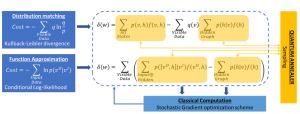Presented By: Aerospace Engineering
Graph Theoretic Algorithms Adaptable to Quantum Computing
Aerospace PhD Defense, Siddhartha Srivastava

This thesis is the first effort towards solving scientific computing problems using graph-based algorithms amenable to quantum computers and specifically, quantum annealers.
Many engineering problems, when considered in a discrete computational setting, can be reduced to a graph coloring problem. Examples range from systems design, image segmentation to pattern recognition where energy cost functions with discrete variables are extremized.
However, graph techniques remain under-utilized in scientific computing. However, we have recently witnessed great advancements in quantum computing where physical devices are available that can solve discrete optimization problems faster than most well-known classical algorithms.
This warrants further investigation into re-formulation of scientific computation problems as graph theoretic problems, and thus enable rapid engineering simulations in a soon-to-be quantum computing world. The computational techniques developed in this thesis allow representation of surface scalars like perimeter and area using discrete variables in a graph. With this framework, several quantities important to engineering applications can be represented in graph based algorithms.
These include: surface energy of cracks for fracture prediction, grain boundary energy to model microstructure evolution, estimate surface areas (of grains, fibers) to generate conformal meshes of microstructures, etc. Combinatorial optimization problems for these applications are first presented.
The last two chapters of the thesis describes two new graph coloring algorithms implemented on a physical quantum computing device: the D-wave quantum annealer. The first algorithm describes a functional minimization approach to solve differential equations. The second algorithm describes a realization of Boltzmann machine learning algorithm on a quantum annealer, with open source codes available on GitHub. The latter allows generative and discriminative learning of data which has vast applications in many fields.
Many engineering problems, when considered in a discrete computational setting, can be reduced to a graph coloring problem. Examples range from systems design, image segmentation to pattern recognition where energy cost functions with discrete variables are extremized.
However, graph techniques remain under-utilized in scientific computing. However, we have recently witnessed great advancements in quantum computing where physical devices are available that can solve discrete optimization problems faster than most well-known classical algorithms.
This warrants further investigation into re-formulation of scientific computation problems as graph theoretic problems, and thus enable rapid engineering simulations in a soon-to-be quantum computing world. The computational techniques developed in this thesis allow representation of surface scalars like perimeter and area using discrete variables in a graph. With this framework, several quantities important to engineering applications can be represented in graph based algorithms.
These include: surface energy of cracks for fracture prediction, grain boundary energy to model microstructure evolution, estimate surface areas (of grains, fibers) to generate conformal meshes of microstructures, etc. Combinatorial optimization problems for these applications are first presented.
The last two chapters of the thesis describes two new graph coloring algorithms implemented on a physical quantum computing device: the D-wave quantum annealer. The first algorithm describes a functional minimization approach to solve differential equations. The second algorithm describes a realization of Boltzmann machine learning algorithm on a quantum annealer, with open source codes available on GitHub. The latter allows generative and discriminative learning of data which has vast applications in many fields.